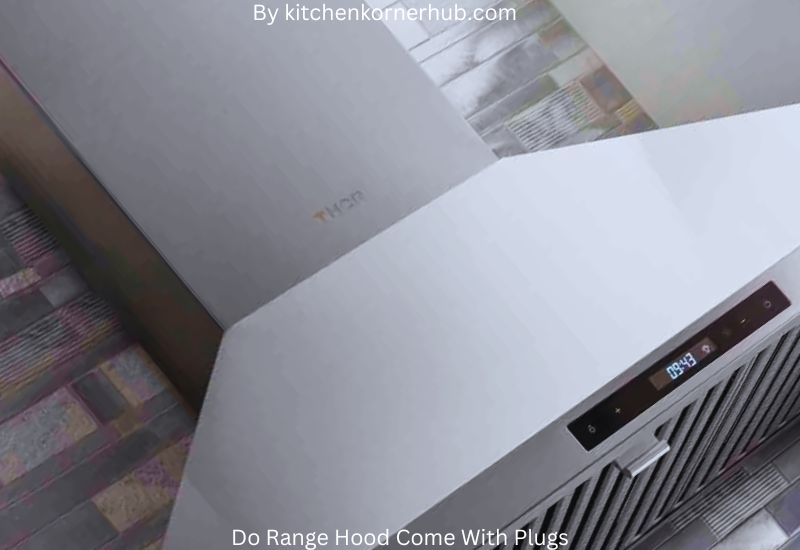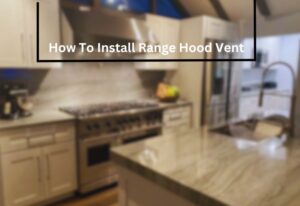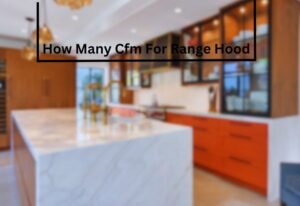Are you wondering whether range hoods come with plugs? Well, you’re not alone! Range hoods are essential kitchen appliances that help keep your kitchen clean and free from cooking odors. However, when it comes to installation, the question of whether they come with plugs is quite common.
Do Range Hood Come With Plugs? Yes, most range hoods do come with plugs. They are designed to be plugged into standard electrical outlets for ease of installation. However, it’s important to check the specific model and manufacturer’s instructions to ensure compatibility and safety. Some may require hardwiring by a professional electrician. Always follow the manufacturer’s guidelines for proper installation.
In this article, we’ll delve into this topic to provide you with a straightforward answer. We’ll discuss the different types of range hoods and their electrical requirements, so you can make an informed decision when setting up your kitchen. So, if you’re curious about range hood plugs and want to ensure a hassle-free installation, keep reading to learn more.
“Unplugged Secrets: Understanding the Electrical Setup of Range Hoods”

Range hoods are essential appliances in our kitchens, quietly working to eliminate odors, smoke, and grease. Yet, their electrical setup might seem like a mystery to many homeowners. In this guide, we’ll delve into the unplugged secrets behind the electrical setup of range hoods, shedding light on how they function and how to ensure they work seamlessly in your kitchen.
The Basics of Range Hood Electrical Connection
At its core, a range hood’s electrical setup is quite straightforward. It requires a dedicated electrical circuit, typically connected to a switch on your kitchen wall. This circuit powers the range hood’s fan and lighting. It’s crucial to have a dedicated circuit to prevent overloading and ensure safety during operation.
Voltage and Amperage Requirements
Range hoods usually run on 120 volts of electricity. Understanding the voltage requirement is essential when installing or replacing a range hood.
Additionally, check the amperage rating to ensure your electrical circuit can handle the load. This information can be found in the range hood’s user manual or on a label inside the unit.
Wiring the Range Hood
To wire your range hood, you’ll need to connect the black wire (hot), the white wire (neutral), and the green or bare wire (ground) to the corresponding wires in your electrical circuit. Follow the manufacturer’s instructions carefully, as wire colors may vary, and improper wiring can be hazardous.
Installing a Dedicated Circuit
If your kitchen doesn’t have a dedicated circuit for the range hood, it’s advisable to hire a licensed electrician to install one. Attempting to draw power from an existing circuit can lead to tripped breakers and fire hazards.
A dedicated circuit ensures the range hood operates independently, without interference from other appliances.
The Importance of Grounding
Proper grounding is essential for the safety of your range hood and your home. The green or bare wire should be securely connected to the grounding terminal. This prevents electrical shock and ensures the safe dissipation of excess electrical charge.
Regular Maintenance and Safety
Once your range hood is installed, it’s vital to perform regular maintenance, such as cleaning the filters and inspecting the wiring for any signs of wear or damage. This not only prolongs the life of your appliance but also ensures continued safe operation.
“Plug and Play? Exploring the Power Connection Options for Range Hoods”

Range hoods are an essential part of our kitchens, helping to keep the air clean and grease-free while we cook. When it comes to powering these kitchen workhorses, there are several options to consider.
In this note, we’ll delve into the various power connection choices available for range hoods to help you make an informed decision for your kitchen setup.
Hardwired Installation
One of the most common methods of powering a range hood is through hardwiring. This involves connecting the hood directly to your home’s electrical system.
It provides a stable and permanent power source, ensuring consistent performance. However, it may require the expertise of an electrician for installation, making it a less DIY-friendly option.
Plug and Play with a Standard Outlet
For those who prefer a more straightforward approach, many range hoods come with a standard plug that can be connected to a regular electrical outlet. This option is user-friendly and allows for easy installation and relocation if needed. Just make sure your kitchen has a suitable outlet in a convenient location.
Convertible Range Hoods
Some range hoods offer versatility by allowing both hardwired and plug-in options. These convertible hoods can adapt to your kitchen’s power needs, offering the best of both worlds. This flexibility can be especially useful if you’re uncertain about your long-term kitchen setup.
Battery-Powered Range Hoods
In situations where hardwiring or standard outlets aren’t readily available, battery-powered range hoods can come to the rescue. These hoods use rechargeable or replaceable batteries, making them entirely wireless.
While convenient in terms of installation, you’ll need to stay on top of battery maintenance to ensure uninterrupted performance.
Ductless Range Hoods
Ductless range hoods are unique in that they don’t require any external venting. Instead, they utilize a combination of filters and fans to purify the air. These hoods often come with plug-in options, making them a suitable choice for kitchens without ductwork.
Consider Your Kitchen Layout
When deciding on the power connection for your range hood, consider your kitchen’s layout and your personal preferences.
If you’re remodeling or building a new kitchen, you may have more flexibility in choosing the most suitable option. Existing kitchens may require more consideration and potential adjustments.
Safety First
Regardless of the power connection option you choose, safety should always be a priority. Ensure that the installation is done according to local electrical codes and regulations. If you’re not confident in your DIY skills, it’s wise to consult a professional electrician to avoid any safety hazards.
“DIY or Pro Installation: The Role of Electrical Outlets for Range Hoods”

Introduction:
When it comes to range hoods, whether to opt for a DIY installation or hire a professional can be a critical decision. Among the many aspects to consider, the role of electrical outlets plays a pivotal role in ensuring the safe and efficient operation of your range hood. In this note, we will explore the importance of electrical outlets in range hood installations and the pros and cons of both DIY and professional installation methods.
Understanding
Electrical Outlets: Electrical outlets are essential components in range hood installations, as they provide the necessary power supply for the unit to function.
Range hoods typically require a dedicated electrical circuit with the appropriate voltage and amperage, ensuring they work effectively in removing cooking odors, smoke, and grease from your kitchen.
DIY Installation:
Many homeowners choose the DIY route for range hood installation to save costs. However, installing electrical outlets for a range hood can be challenging, especially if you lack electrical expertise.
DIYers need to ensure that the wiring and circuitry meet safety standards, and that the outlet is correctly positioned to accommodate the hood’s power cord.
Pros of DIY Installation:
- Cost Savings: DIY installation can save money on professional labor.
- Sense of Accomplishment: Completing a DIY project can be personally rewarding.
Cons of DIY Installation:
- Safety Risks: Inadequate wiring or incorrect installation can lead to electrical hazards.
- Technical Knowledge: Lack of electrical expertise may result in errors.
Professional Installation: Hiring a certified electrician or technician for range hood installation guarantees that electrical outlets are installed correctly and safely. Professionals ensure that the electrical work meets local building codes and regulations, reducing the risk of accidents.
Pros of Professional Installation:
- Safety Assurance: Professionals guarantee safe and compliant installations.
- Expertise: Certified technicians have the necessary knowledge and experience.
- Warranty Coverage: Many manufacturers require professional installation to uphold warranties.
Cons of Professional Installation:
- Cost: Hiring professionals can be more expensive than a DIY approach.
- Scheduling: Appointments may need to be arranged, potentially causing delays.
“Hidden Wires, Hidden Costs: What You Need to Know About Range Hood Electrical”

Introduction: Installing a range hood in your kitchen is a smart choice for keeping your kitchen air clean and smoke-free. However, there’s more to it than just choosing the right model.
Understanding the electrical aspects of range hoods is crucial to avoid hidden costs and ensure safe operation. In this note, we will explore the essential information you need to know about range hood electrical.
Power Requirements:
When installing a range hood, the first thing to consider is its power requirements. Range hoods typically require electrical power to operate, and it’s essential to know the voltage and current needed. Make sure your kitchen’s electrical system can support these requirements without overloading the circuit.
Wiring Considerations:
Hidden wires behind the range hood are critical for its functionality. You may need to hire a licensed electrician to install the wiring correctly. Ensure that the wiring is concealed properly to maintain a neat appearance in your kitchen.
Ventilation Fan:
The main function of a range hood is to remove smoke and odors. The ventilation fan is the heart of the hood, and it requires electrical power to operate efficiently.
Be aware that the fan’s power consumption may affect your energy bills, so choose an energy-efficient model if possible.
Lighting:
Many range hoods come with built-in lights to illuminate your cooking area. These lights also require electrical connections. Understanding the lighting options and their power consumption can help you make the right choice for your kitchen.
Safety Features:
Range hoods often have safety features like thermal sensors that can shut down the unit in case of overheating. These features rely on electrical components, so ensure they are functioning correctly to prevent potential hazards.
Maintenance and Repairs:
Hidden costs can arise when it comes to maintaining and repairing your range hood. Regular cleaning of filters and fans can prolong the life of your hood and reduce the need for costly repairs. It’s essential to follow the manufacturer’s maintenance guidelines.
Installation Costs:
Beyond the cost of the range hood itself, budget for the installation. Hiring a professional electrician may be necessary to ensure the electrical work is done safely and in compliance with local codes. This cost should be factored into your overall budget.
“Range Hood Installation 101: Deciphering the Plug-In Possibilities”

When it comes to setting up a range hood in your kitchen, it’s essential to understand the various plug-in options available. This guide will help you navigate the world of range hood installation, making it a breeze for even the DIY novice.
Gather Your Tools and Materials:
Before diving into installation, ensure you have the necessary tools and materials. You’ll typically need a screwdriver, a measuring tape, a level, and, of course, your chosen range hood.
Check Your Kitchen Layout:
Examine your kitchen’s layout to determine the most suitable location for your range hood. Ideally, it should be centered above your cooktop or stove. Make sure there’s an electrical outlet nearby.
Ventilation Options:
Range hoods come in two primary ventilation types: ducted and ductless. Ducted hoods vent cooking odors and smoke outside, while ductless ones use filters to purify and recirculate the air. Choose the one that best fits your kitchen setup and needs.
Plug-In or Hardwired:
The plug-in possibility refers to range hoods that come with a standard power cord for easy installation into a nearby electrical outlet.
Alternatively, some models may require hardwiring, which involves connecting directly to your home’s electrical system. Make sure to choose a range hood that matches your preferred installation method.
Mounting the Range Hood:
Securely mount the range hood using the provided hardware. Use a level to ensure it’s straight, and follow the manufacturer’s instructions carefully. For ducted hoods, you’ll need to install the ductwork as well.
Connect the Power:
If you’ve chosen a plug-in range hood, simply plug it into the nearby electrical outlet. For hardwired models, consult a professional electrician to ensure a safe and compliant installation.
Test and Maintenance:
After installation, test your range hood to ensure it’s functioning correctly. Regularly clean or replace filters (if applicable) and keep the hood’s surface clean to maintain its efficiency.
Conclusion
In conclusion, range hoods typically don’t come with plugs. You’ll need to buy and install the right plug separately, based on your kitchen setup and local electrical codes. This allows for flexibility in wiring and ensures safety. Remember to consult a professional if you’re unsure about the installation process. Properly setting up your range hood not only keeps your kitchen smelling fresh but also promotes a safer cooking environment. So, when it comes to plugging in your range hood, it’s a small but important step towards a better cooking experience.
Frequently Asked Question(Do Range Hood Come With Plugs)
Does the vent hood need a plug?
When it comes to a vent hood, you might wonder if it needs a plug. The answer is yes, it typically does need a plug. Vent hoods are designed to remove smoke, steam, and odors from your kitchen while cooking. To do this, they have a fan and sometimes even a light.
These components require electricity to function, and that’s where the plug comes in. Most range hoods come with a power cord that you can plug into an electrical outlet. If there isn’t an existing outlet in your kitchen, you may need to have one installed by a qualified electrician to ensure the hood works properly.
What is included in a range hood?
Now, let’s talk about what’s included in a range hood. When you purchase a range hood, you’ll generally get the main hood unit itself, which houses the fan and filters. Depending on the model, it may also include a lighting fixture. Some range hoods come with a power cord and plug, while others may require you to purchase these separately.
Additionally, you’ll often find included hardware for mounting the hood to your kitchen wall or ceiling. However, ducting is not usually included with range hoods, and you’ll need to buy it separately if you want to vent the hood to the outside.
How do you connect a power cord to a range hood?
Connecting a power cord to a range hood is a relatively straightforward process. First, you’ll need to make sure the range hood is correctly installed in your kitchen, following the manufacturer’s instructions. Once that’s done, you’ll usually find a connection point for the power cord inside the hood.
You’ll attach the wires from the cord to the corresponding wires inside the hood, typically following a color-coded scheme (black to black, white to white, and green or bare copper to the green grounding wire). It’s crucial to make sure all connections are secure and insulated properly to prevent any electrical hazards. If you’re not comfortable with electrical work, it’s always a good idea to hire a professional electrician to make the connection safely.
Do range hoods come with ducting?
Lastly, regarding ducting, most range hoods do not come with ducting included. Ducting is the tubing or piping that directs the air and odors from the hood to the outside of your home. The reason ducting is not typically included is that it can vary greatly depending on your kitchen’s layout and the desired venting path.
You’ll need to purchase the appropriate ducting separately, taking into account the length, diameter, and any additional accessories required for the specific installation. It’s essential to choose the right size and type of ducting to ensure that your range hood operates efficiently.




